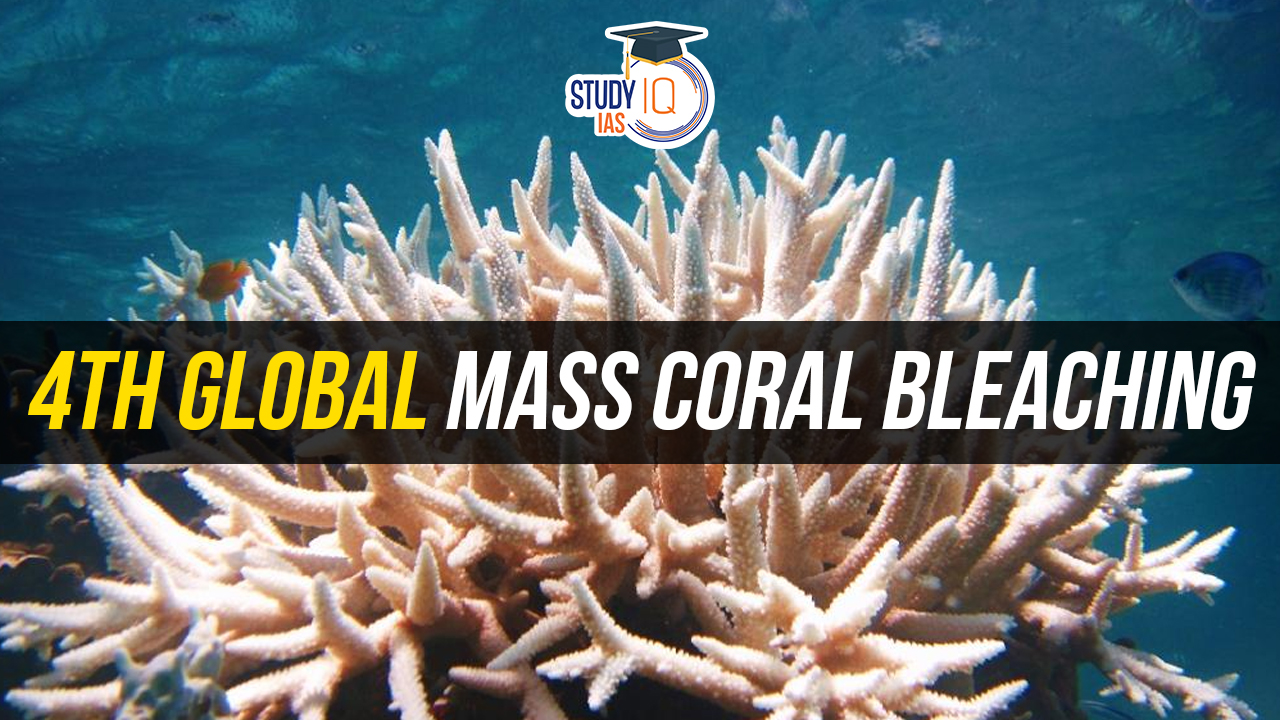Table of Contents
Context: The US National Oceanic and Atmospheric Administration (NOAA) reported that the fourth global mass coral bleaching event has been triggered by extraordinary ocean temperatures.
What Are Coral and Coral Reefs?
About Corals
- Corals are sessile animals that attach permanently to the ocean floor.
- They use tiny tentacle-like appendages to capture food from the water and sweep it into their mouths. Each individual coral is known as a polyp, and they live in large groups of hundreds to thousands of genetically identical polyps forming a ‘colony’.
- Corals are categorised into two main types: hard coral and soft coral.
- Hard corals build the coral reefs by producing stony skeletons made out of limestone, according to NOAA.
- These skeletons remain after the polyps die and serve as the foundation for new polyps.
About Coral Reefs
- Coral reefs are massive underwater structures made of limestone deposited by coral polyps.
- Dubbed the “rainforests of the sea,” they have been around for nearly 450 million years.
- They are among the most diverse ecosystems on Earth, supporting 25 percent of all known marine species, thus referred to as the ‘rainforests of the seas’.
- Formation of coral reefs:
- Coral polyps are tiny marine animals that live in colonies.
- They secrete hard exoskeletons made of calcium carbonate.
- Over millions of years, these exoskeletons build up to form coral reefs.
- Conditions required for coral reef formation:
- Sunlight (Photic): Corals need to grow in shallow water where sunlight can reach them.
- Clear water: Corals need clear water that lets sunlight through.
- Warm water temperature: Corals generally thrive in water temperatures of 20–32° C.
- Clean water: Corals are sensitive to pollution and sediments.
- Saltwater: Average salinity required is between 27% to 40%.
- Types of Coral Reefs:
- Fringing Reefs: These grow close to shorelines, such as the Great Barrier Reef in Australia.
- Barrier Reefs: Separated from the coast by a lagoon, like the Belize Barrier Reef.
- Atolls: Circular reefs surrounding a lagoon, as seen in the Maldives and French Polynesia.
- Patch Reefs: Isolated coral formations in open water, like the Flower Garden Banks in the Gulf of Mexico.
- Ribbon Reefs: Long, narrow reefs often found in the Coral Sea.
- Tabletop Reefs: Flat, table-like structures, found in parts of the Great Barrier Reef.
- Significance
- Biodiversity Hotspots: Coral reefs are crucial for marine ecosystems, supporting vast biodiversity.
- For example, the Great Barrier Reef hosts over 400 coral species, 1,500 fish species, 4,000 mollusc species, and six of the world’s seven sea turtle species.
- Economic and Environmental Importance: Coral reefs provide economic goods and services valued at approximately $375 billion annually.
- They are essential for over 500 million people worldwide for food, income, and coastal protection.
- Coral reefs can absorb up to 97% of the energy from waves, storms, and floods, protecting against loss of life, property damage, and soil erosion.
- Impact on Human and Marine Life: The disappearance of coral reefs would have devastating effects on both marine life and human populations, due to loss of biodiversity and breakdown of the protective barriers they provide
- Biodiversity Hotspots: Coral reefs are crucial for marine ecosystems, supporting vast biodiversity.
- Location and Distribution:
- Most coral reefs are located between the Tropics of Cancer and Capricorn, in the Pacific Ocean, the Indian Ocean, the Caribbean Sea, the Red Sea, and the Persian Gulf.
- Corals are also found farther from the equator in places where warm currents flow out of the tropics, such as in Florida and southern Japan.
- Worldwide, coral reefs cover an estimated 110,000 square miles (284,300 square kilometres).
- Coral reefs are absent on the west coast of tropical continents because of the presence of cold coastal currents.
- Coral Reefs in India:
- The Coral reefs in India are mainly restricted to the Andaman and Nicobar Islands, Gulf of Mannar, Gulf of Kutch, Palk Strait and the Lakshadweep islands.
- All of these reefs are Fringing reefs, except Lakshadweep which are Atolls.
- There are Patchy corals present along the intertidal areas of the central west coast like the intertidal regions of Ratnagiri, Gaveshani Bank etc.
What is Coral Bleaching?

Coral bleaching is a process where corals, which are very sensitive to changes in light and temperature, expel the algae (zooxanthellae) living in their tissues due to stress.
- Symbiotic Relationship: Corals and zooxanthellae (plant-like organisms) have a symbiotic relationship.
- Corals provide a safe habitat for the zooxanthellae, while the algae supply oxygen and organic products from photosynthesis.
- This helps corals grow and lends them their vibrant colours.
- Causes of Bleaching: When corals are stressed by changes in conditions such as temperature or light, they expel the zooxanthellae.
- This loss turns the corals white, an event known as coral bleaching.
Consequences of Bleaching
- Immediate Effects: Bleaching does not immediately kill corals but puts them under more stress, increasing their susceptibility to mortality.
- Long-Term Impact: Bleached corals suffer from reduced reproductive capacity and heightened vulnerability to diseases.
- Potential for Recovery: If the bleaching is not too severe, corals can recover over time.
Global Impact
- Global Mass Bleaching Events: Significant coral bleaching across the Atlantic, Indian, and Pacific oceans is considered a global mass bleaching event. These are relatively recent phenomena, with the first recorded event in 1998.
- Historical Events:
- 1998: The first global bleaching event affected 20% of the world’s coral reefs.
- 2010: The second event saw 35% of reefs impacted.
- 2014-2017: The most extensive bleaching occurred during this period, affecting 56% of global reef areas.
Current Status of Coral Bleaching
- Fourth Global Bleaching Event: The US National Oceanic and Atmospheric Administration (NOAA) has confirmed the onset of the fourth global coral bleaching event.
- Widespread Impact: This event has affected reefs in 54 countries and regions, including Florida (US), Saudi Arabia, and Fiji. Notably, the Great Barrier Reef is experiencing its most severe bleaching to date.
- Extent of Damage: Preliminary surveys indicate about a third of the Great Barrier Reef has shown very high to extreme bleaching levels. Overall, more than 54% of the world’s coral areas have faced bleaching-level heat stress over the past year.
Causes and Predictions
- Heat Stress: Elevated ocean temperatures are the primary cause of the current bleaching event.
- Exacerbating Factors: The situation is worsened by El Niño, which is known for causing warmer ocean conditions.
- Future Conditions: With the weakening of El Niño and potential onset of a cooler La Niña later in the year, there might be some temporary relief for coral reefs.
Potential Impacts
- Severity and Frequency: This bleaching event is described as the most severe yet. Scientists predict that such bleaching events will become more frequent and prolonged due to global warming.
- Long-Term Projections: According to a 2018 report by the Intergovernmental Panel on Climate Change (IPCC), significant coral loss is expected at 1.5 degrees Celsius of warming, with nearly total loss if temperatures rise by 2 degrees.
- Current Global Temperature Increase: Since 1850, the Earth’s average temperature has increased by at least 1.1 degrees Celsius.


 India to Host First Global Conference on...
India to Host First Global Conference on...
 How Terror Networks Abuse Digital Tools
How Terror Networks Abuse Digital Tools
 United Nations Population Award 2025: Va...
United Nations Population Award 2025: Va...





















